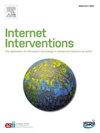数字干预对八种精神障碍的有效性:荟萃分析综合
IF 4.1
2区 医学
Q1 HEALTH CARE SCIENCES & SERVICES
Internet Interventions-The Application of Information Technology in Mental and Behavioural Health
Pub Date : 2025-07-11
DOI:10.1016/j.invent.2025.100860
引用次数: 0
摘要
在这个统一的荟萃分析系列中,我们整合了数字干预对成人精神障碍患者的影响,并将其与非活动对照组进行了比较。我们涵盖了八种适应症:抑郁症、失眠、特定恐惧症、广泛性焦虑、恐慌、社交焦虑、强迫症和创伤后应激障碍。方法从Metapsy生活数据库中提取经临床访谈证实的精神障碍患者的数字化干预试验,用于心理治疗。标准化的荟萃分析用于汇总每种疾病的效果,并分别用于指导和非指导治疗。我们还检查了研究的辍学率,进行了按障碍分层的meta回归分析,并确定了在常规护理中作为处方数字治疗方法可用的治疗方法。结果共纳入168项研究(22144例患者)。PTSD (g = 0.57)、抑郁症(g = 0.62)和强迫症(g = 0.68)的效应值为中等。广泛性焦虑(g = 0.80)、社交焦虑(g = 0.84)、失眠(g = 0.94)、惊恐障碍(g = 1.05)和特定恐惧症(g = 1.18)出现了较大的影响。合并研究的辍学率一般为中等(≤20%),但干预组的辍学率较高(RR = 1.13-2.66)。低偏倚风险和照旧比较的试验在适应症上受到限制。我们发现了16个评估处方数字治疗的试验(g = 0.33-1.60)。结论数字干预可以在广泛的诊断精神障碍中有效。对于某些适应症,需要更多高质量的试验和与常规护理的比较来证实效果的稳健性,特别是对于无指导治疗。数字干预作为可处方的数字治疗方法日益商业化。越来越多的行业参与可能为该领域带来机遇和新的挑战。本文章由计算机程序翻译,如有差异,请以英文原文为准。
Effectiveness of digital interventions for eight mental disorders: A meta-analytic synthesis
Objectives
In this unified series of meta-analyses, we integrate the effects of digital interventions in adults with mental disorders compared to inactive controls. We cover eight indications: depressive disorder, insomnia, specific phobias, generalized anxiety, panic, social anxiety, obsessive-compulsive, and posttraumatic stress disorder.
Methods
Digital intervention trials in patients with a diagnosed mental disorder (confirmed by clinical interviews) were extracted from the Metapsy living databases for psychological treatments. Standardized meta-analyses were conducted to pool effects for each disorder, as well as separately for guided and unguided treatments. We also examined study dropout rates, conducted meta-regression analyses stratified by disorder, and identified treatments that have since become available as prescribable digital therapeutics in routine care.
Results
In total, 168 studies (22,144 patients) were included. Moderate effect sizes were observed for PTSD (g = 0.57), depression (g = 0.62), and obsessive-compulsive disorder (g = 0.68). Large effects emerged for generalized anxiety (g = 0.80), social anxiety (g = 0.84), insomnia (g = 0.94), panic disorder (g = 1.05), and specific phobias (g = 1.18). Pooled study dropout rates were generally moderate (≤20 %), but higher in intervention arms (RR = 1.13–2.66). Trials with low risk of bias and care-as-usual comparisons were limited across indications. We found 16 trials evaluating a prescribable digital therapeutic (g = 0.33–1.60).
Conclusions
Digital interventions can be effective across a wide range of diagnosed mental disorders. For some indications, more high-quality trials and comparisons against care-as-usual are needed to confirm the robustness of the effect, particularly for unguided treatments. Digital interventions are increasingly commercialized as prescribable digital therapeutics. Rising industry involvement may present both opportunities and new challenges for the field.
求助全文
通过发布文献求助,成功后即可免费获取论文全文。
去求助
来源期刊

Internet Interventions-The Application of Information Technology in Mental and Behavioural Health
Medicine-Health Informatics
CiteScore
6.50
自引率
9.30%
发文量
94
审稿时长
6 weeks
期刊介绍:
Official Journal of the European Society for Research on Internet Interventions (ESRII) and the International Society for Research on Internet Interventions (ISRII).
The aim of Internet Interventions is to publish scientific, peer-reviewed, high-impact research on Internet interventions and related areas.
Internet Interventions welcomes papers on the following subjects:
• Intervention studies targeting the promotion of mental health and featuring the Internet and/or technologies using the Internet as an underlying technology, e.g. computers, smartphone devices, tablets, sensors
• Implementation and dissemination of Internet interventions
• Integration of Internet interventions into existing systems of care
• Descriptions of development and deployment infrastructures
• Internet intervention methodology and theory papers
• Internet-based epidemiology
• Descriptions of new Internet-based technologies and experiments with clinical applications
• Economics of internet interventions (cost-effectiveness)
• Health care policy and Internet interventions
• The role of culture in Internet intervention
• Internet psychometrics
• Ethical issues pertaining to Internet interventions and measurements
• Human-computer interaction and usability research with clinical implications
• Systematic reviews and meta-analysis on Internet interventions
 求助内容:
求助内容: 应助结果提醒方式:
应助结果提醒方式:


